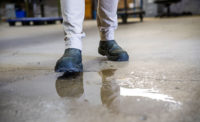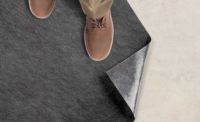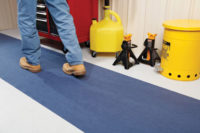Slips and falls to the same level are the second leading cause of lost worktime injuries, and the cause of 171 employee deaths in 2014, according to the Bureau of Labor Statistics. Identifying and eliminating the most common causes of these injuries can reduce OSHA recordable incidents and workers compensation claims.
Not every contributing factor of a slip and fall injury can be controlled. For example, as employees age, their eyesight, gait, balance, mobility and ability to concentrate on a task can all diminish or become impaired. Although employees can be taught to be aware of biological changes and can even be taught to walk more slowly or with shorter steps, these factors can’t be eliminated and, at best are difficult to try to manage.
Focusing on factors that can be more readily managed or controlled will provide greater results. In a study conducted by the National Floor Safety Institute (NFSI), over 50 percent of slip and fall injuries were caused by problems with the walking surface. Taking the time to identify these and other external factors will aid in creating good housekeeping and maintenance practices to eliminate workplace slip and fall hazards.
Liquid leaks, drips and spills
Most industrial processes rely on at least one type of liquid to operate. It may be oil, a coolant, water or a proprietary blend of chemicals. These fluids can spill, splash, leak, drip or spray onto walking surfaces, making them slippery. It is often impossible to eliminate liquids from a process, so stocking absorbents, mops, wipes or spill kits in any area where liquids are stored, transferred or used and teaching employees how to use them will facilitate fast cleanup so that the liquids don’t present a slip hazard. For areas that are constantly wet, like kitchens or processes involving dip tanks, consider perforated floor mats or grating that keep fluids below the walking surface or slip-resistant finishes that add traction to floors.
Liquid leaks and spills aren’t isolated to manufacturing or production areas. Uncarpeted floors in offices, cafeterias, break rooms, foyers and hallways can also become slippery when employees don’t clean up food and drink spills. Making sure that these common areas have adequate supplies of paper towels or napkins and conveniently located trash receptacles will help to encourage everyone to clean up their messes promptly.
Injuries don’t always occur inside a facility. Last year, almost 35,000 employees experienced a lost worktime slip and fall injury involving ice, sleet or snow. Having a plan to manage parking lots, sidewalks and building entrances during inclement weather will minimize the chance for slips and falls.
Dry contaminants
Liquids aren’t the only thing that can make a floor slippery. Dust, dirt, sand, cat litter and metal shavings can be equally hazardous. Because they can be harder to see than liquid spills, dry contaminants can sometimes be more hazardous than spilled liquids – especially on smooth, un-textured or untreated floors.
Review floor maintenance schedules to determine if floors are being cleaned often enough to prevent dry contaminants from making walkways slippery. If fine dusts are an issue, consider using sweeping compounds to keep the dust from spreading and being redeposited on the floor when it is being swept. For some facilities, vacuums may provide better, longer lasting results than sweeping.
Uneven surfaces
One of the most common examples of an uneven surface is a brick sidewalk that has been poorly maintained. Large cracks in parking lot asphalt that have been subject to freeze and thaw cycles, and door frames that are not recessed for flush with the floor are also classic examples. But uneven surfaces aren’t limited to outdoor locations or entrances. Any change in elevation of more than ¼” can cause a worker to trip and fall.
It is a good practice to check for uneven surfaces at least quarterly, or with the change of each season. Use signs or otherwise mark areas where variations are found until they can be corrected.
Improper footwear
Improper footwear is the second leading cause of slip and fall injuries, according to NFSI. The image of a restaurant worker in shoes that aren’t slip-resistant may come to mine, but most times, those employees are actually accustomed to walking on slippery surfaces and learn to adjust their gait and stride to prevent slips and falls. No shoe – even those marketed as slip-resistant or slip proof – can guarantee that a slip and fall injury won’t happen, but smooth-soled dress shoes, extremely high heels, sandals and flip-flops can all increase the likelihood of an incident.
In areas that are routinely wet or slippery, slip resistant footwear can help to minimize incidents. Be sure to match the sole of the shoe to the type of contaminant that will be present. When slip-resistant footwear is issued, it should be considered a form of personal protective equipment, and be checked regularly for signs of wear so that it can be replaced when the soles are worn.
Poor lighting
Spills, obstacles and uneven surfaces are all harder to identify in the dark. Low or insufficient lighting can hide or disguise walking surface hazards both indoors and out.
For some areas, a simple solution may be to increase the wattage of the lamps or bulbs used in lighting fixtures. In other areas, additional lighting devices may be needed. Light level meters are inexpensive and can help determine areas throughout the facility that have low lighting levels. For areas that are not always occupied but that need additional lighting, consider motion sensors to conserve energy. Many local building codes specify minimum lighting requirements for both parking lots and occupied structures.
Distractions
Because most people have been walking for as long as they can remember, they take the skill for granted and don’t pay full attention to the task. Talking on cell phones, reading printed documents, checking information on computer tablets, talking with colleagues and carrying boxes are things that people commonly do while walking from one place to another.
Many people may not even acknowledge these distractions while walking. Unlike a spill that can be wiped up or lighting that can be installed or replaced, workplace distractions tend to be harder to control. Using toolbox talks, intranet reminders and posters throughout the facility can help draw attention to the need to be on-task when walking. If distractions continue to be a common cause of slip and fall injuries, formal “no phone” or “no distraction” policies can also be developed.



